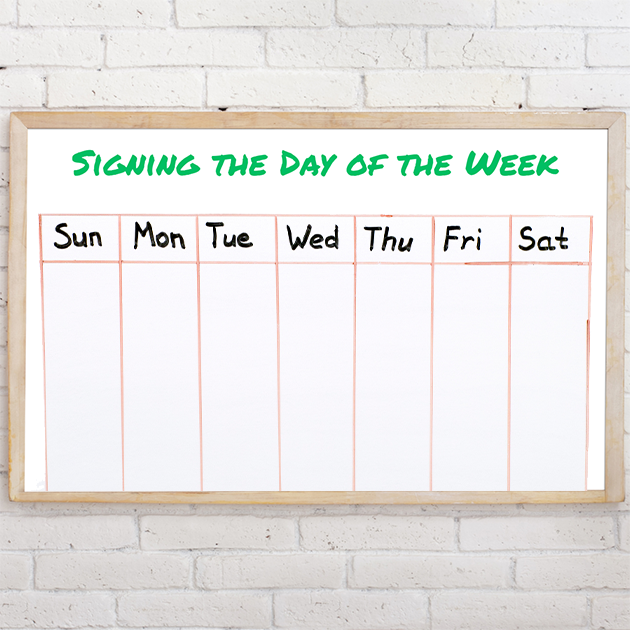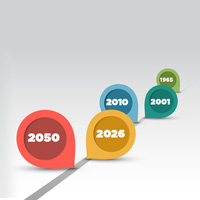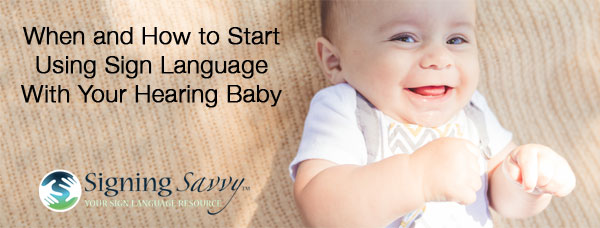
When and How to Start Using Sign Language With Your Hearing Baby
When to start signing with your hearing baby?
Experts recommend to start talking to your child at birth – even newborns benefit from hearing speech and talking to your child is an important part of how they learn language and to speak. You can talk to them, describe what you are doing as you’re doing it, describe what’s going on around you, tell stories, sing songs, and read books.
Because we would talk to our son when he was born, it just seemed natural to also start signing right away as well. Plus, research has shown signing activates the area of the brain that makes learning a new word easier,1 2 so why not! It’s never too early (or late) to start signing with children. Babies as young as 4 months old can start using signs (signing them) if they have been introduced to the signs for at least a month.3 The wait for the first sign is usually the longest, but often there will be an increase of signs used.4 Don’t be discouraged if your child is older, it is never too late to start learning sign language and there are benefits to learning sign language at any age.
How many signs should we start with?
There isn’t an ideal number of signs to start with. Many children grow up in bilingual households and are able to learn multiple languages. How many signs you start using with your baby really depends on what works for you and your family.
- If you are a fluent or native signer, use sign language all of the time.
- If you are not a fluent signer, but have a deaf infant, try to learn ASL yourself and use it as much as you can.
- If you are excited about learning sign language, learn as much as you can and incorporate as much as you can into your daily language.
- If you’re new to sign language and want to start signing with your hearing baby, the key is to do what you’re comfortable with and don’t get overwhelmed. Start with a few signs and go from there. Add more signs as it makes sense to do so, just keep with it! Being able to communicate with your baby using sign before they can talk is rewarding for both you and your child.
We are hearing parents of hearing children. When we started signing with our first son, we wouldn’t sign everything we said, just the words that were most common to his world. For example, when saying, “Do you want milk?” We would just sign MILK (with the appropriate facial expression for asking a question). Eventually we would add more signs, such as MILK + WANT.
Repetition is also an important part to learning new things, so we tried to be consistent in the signs that we used and picked signs that would occur naturally during a typical day. Now, with our second son, in addition to signing signs, I like to fingerspell words to him, like his name, his brother’s name, etc. (I like to have the excuse to practice my fingerspelling!). The “right” way to introduce signs to your baby is whatever works for you and your family, just keep at it and keep adding more signs!
What signs should we start with?
There has been an increasing trend for hearing parents to teach their hearing babies sign language, because of that, there are a number of baby signing resources available and varying opinions on how to do it and how to get started.
The most common recommendations of signs to start with are:
- MOM, DAD
- PLEASE, THANK YOU, HUG, I LOVE YOU
- MILK, EAT / FOOD, WATER, COOKIE, DRINK, THIRSTY, HUNGRY
- MORE, FINISHED / ALL GONE
- BED, SLEEPY, PLAY, BATH, READ, BOOK, SING / SONG
- HOT, COLD
- TEDDY BEAR (or just BEAR), PACIFIER, BLANKET, BOOK, CAR, DOLL
But I wouldn’t recommend starting with the most “common” baby signs or sticking to any get-started list. After all, you’re not creating lesson plans and teaching class, you’re just living life and incorporating signing into your everyday activities. The best strategy is to pick signs that make the most sense in the context of your baby’s life. For example, if your baby doesn’t use a PACIFIER or have a TEDDY BEAR, then there is no reason to have those included in the signs you start with.
You will also want to think about timing – when you start signing with your baby and what they do on a regular basis should have a big influence on the signs you start with. For example, if you start signing right away with your baby, the first signs you choose may be MILK, SLEEP, and POTTY because all they do is eat, sleep and go to the bathroom. You wouldn’t want COOKIE to be one of the first signs at that age because you don’t give a newborn a cookie and it wouldn’t be a regular part of their world yet.
Read our other articles on suggestions of what to sign at different baby ages. These include examples of what I signed with my son and are meant to be a rough guide, but make sure that you only use suggestions as a guide and pick signs that make the most sense in the context of your baby’s world.
You can easily use Signing Savvy to create your own custom word list of signs for each stage or age of your baby’s life. Sharing the word lists you have created is a great way to get other people, like grandparents and babysitters, in the loop on what signs your baby is learning or knows.
Resources
- Kelly, S., McDevitt, T., and Esch, M. (2009). Brief training with co-speech gesture lends a hand to word learning in a foreign language. Language and Cognitive Processes, 24(2), 313-334.
- Xu, J., Gannon, P., Emmorey, K., Smith, J., & Braun, A. (2009). Symbolic gestures and spoken language are processed by a common neural system. Proceedings of the National Academy of Sciences, 106(49), 20664-20669.
- Thorne, B. (2011, August 20). More day care centers, parents using sign language to communicate with babies. MLive. Retrieved 10/29/2014 from http://www.mlive.com/news/flint/index.ssf/2011/08/more_day_care_centers_parents.html
- Berg, L. (2012). The Baby Signing Bible. New York: Penguin Group.
ADVERTISEMENTS
 Use Sign Language to Communicate With Your Hearing Baby Before They Can Talk – An Overview of Why to Use American Sign Language (ASL)
Use Sign Language to Communicate With Your Hearing Baby Before They Can Talk – An Overview of Why to Use American Sign Language (ASL)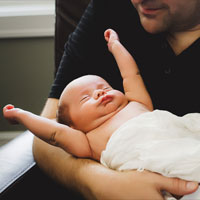 Guide to Using Sign Language With Your Hearing Baby: 0 to 6 Months
Guide to Using Sign Language With Your Hearing Baby: 0 to 6 Months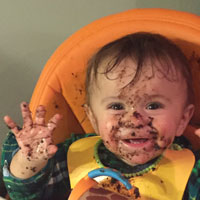 Guide to Using Sign Language With Your Hearing Baby: Signing With Food - Starting at 4 to 6 Months (whenever they start eating)
Guide to Using Sign Language With Your Hearing Baby: Signing With Food - Starting at 4 to 6 Months (whenever they start eating) The Importance of Early Exposure to American Sign Language with Deaf Children
The Importance of Early Exposure to American Sign Language with Deaf Children



